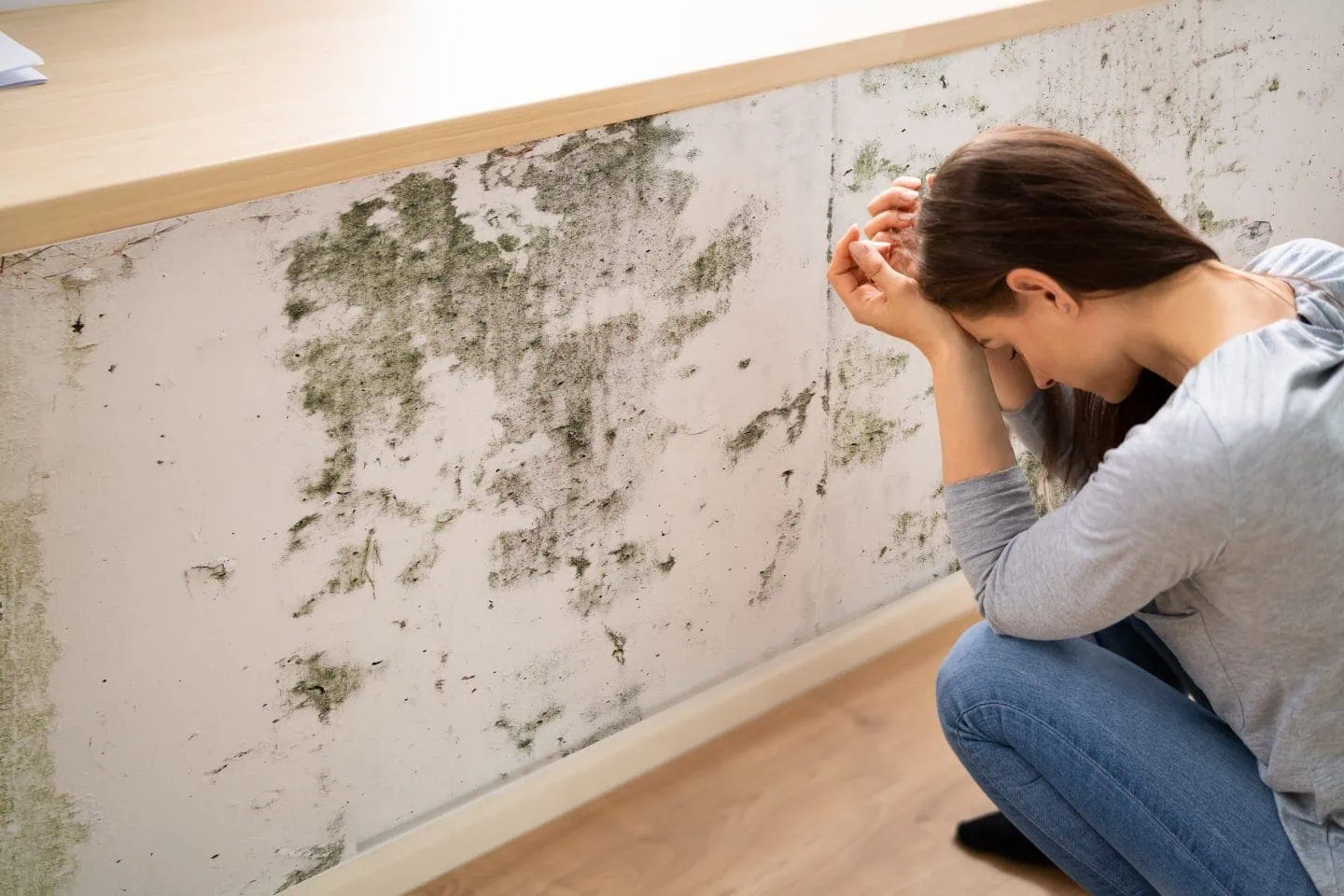How to get rid of mould on walls?
Mould spores are carried in the air. If the conditions for growth are right, mould can develop on walls and ceilings in any home. As soon as it’s noticed, it needs to be removed safely. The longer that mould is left to develop, the higher the chances of it leading to illnesses such as asthma, allergic reactions and respiratory infections.
But, removing mould safely isn’t just a case of a quick wipe-down. If the reasons for growth of the mould aren’t identified and addressed, it will show up time and time again, and become a permanent fixture on the cleaning list.
Our experts have answered your commonly asked questions about mould removal from walls and ceilings. As important, what to do to prevent it from developing again.

If not removed, is mould dangerous?
Mould can be dangerous to health if spores are inhaled in sufficient volume. There are hundreds of species of mould that can be carried in the air, waiting to settle and grow, as long as the conditions are right.
Stachybotrys chartarum, also known as ‘black mould’, is often reported as the most sinister of moulds out there. While it does release mycotoxins that can lead to health problems, other species of mould can cause allergic reactions and respiratory issues, too.
The NHS confirms that mould, not just black mould, can make you more susceptible to respiratory problems, respiratory infections, allergies or asthma, and contribute to immune system damage [1]. Babies, children and individuals with existing medical conditions are more at risk than others, and should stay well away from mould.
If you’re able to, it’s important to remove all mould when it appears, regardless of its species. But, if you are considered high-risk, it’s always safer to employ a specialist cleaning company for mould removal. If you’re experiencing mould in a rental property, we’ve covered your landlord’s responsibilities regarding any health risks, including mould, in our blog on renting under the Homes Fit for Habitation act.
What causes mould on walls and ceilings?
Before getting into mould removal, consider the four things that mould needs to grow in the first place – organic material, moisture, low airflow and no direct sunlight. The cause of mould on your walls and ceilings is a combination of these elements.
We’ll come to prevention methods shortly, but some of these elements can be controlled better than others. Organic matter such as emulsion paint, wooden skirting boards or wallpaper, can’t be changed easily, and not much can be done about getting direct sunlight into specific areas of a property. But, excess moisture is the element that you can control in your home to prevent mould growth.
Persistent dampness caused by excess moisture can cause mould spores to germinate and feed on organic matter, bringing mould to affected surfaces. Even if a wall doesn’t look damp and isn’t wet to touch, there could still be moisture present that provides the right conditions for mould growth.
Excess moisture comes from three main sources.
- High humidity
Humidity is the amount of water vapour in the air. Warm, humid air can allow mould growth, even before it condenses into water droplets on cool surfaces, such as external walls. There’s more information here about what causes condensation and how to reduce it. - Water ingress
Rainwater and groundwater can penetrate through the structure of your home, resulting in internal damp. For example, rising groundwater or rainwater can seep through cracks, gaps or damaged brickwork. Blocked gutters, leaking downpipes and leaking roofs are other common causes of water ingress. - Leaks
Leaks within the home, such as in concealed plumbing or central heating pipework, cause water to saturate building materials. Moisture from even the smallest of leaks will accumulate for mould to grow.
How do I carry out mould removal safely?
As the inhalation of mould can be dangerous, it’s imperative to take safety precautions during mould removal. This includes wearing gloves, a respirator mask and goggles without ventilation holes to protect against touching or inhaling harmful mould spores.
Cleaning mould safely requires minimal disruption of the mould spores to prevent them from becoming airborne. Always use a damp cloth. Wiping mould away with a dry cloth or using the vacuum cleaner will send the mould spores flying, which can increase the likelihood of you inhaling them.
While bleach is often referred to as a common mould cleaner, our experts recommend a mould wash, which is a fungicidal treatment that’s available from most hardware retailers. Bleach will take the colour of mould out of surfaces as opposed to fully removing it, meaning the mould will reappear quicker. In comparison, a mould wash is formulated for the job. Always use the treatment as per the manufacturer’s instructions on the affected area.
Typically, the treatment is applied to the mould and left on the surface for a period of time, such as 20 minutes, before a water rinse is required. Once complete, bag up the cleaning items and seal them to prevent the mould spores from spreading further. Put the bag that contains the used materials in the outdoor bin instead of the household bin as an additional precaution, too.
If you’re concerned about carrying out mould removal, or you consider yourself high-risk, we recommend contacting a specialist cleaning company. Check they have plenty of experience of dealing with mould.
Tip: The only way to truly eliminate mould is to stop the conditions that allow it to grow.
How do I prevent mould from coming back after removal?
The only way to tackle mould for good is by dealing with the underlying cause of the problem. There are products on the market that claim to eradicate mould permanently, but truthfully, the mould will eventually return if the conditions of the problem area remain the same. This includes specialist mould control spray and anti-mould paint, for example.
If you’re experiencing regular mould, it’s best to call a professional to conduct a moisture survey as part of a damp or leak investigation. They can establish where the water source is coming from, whether it’s from condensation, water ingress or a water leak.
Our leak detection specialists use a range of non-invasive detection methods to find hidden sources of excess moisture that lead to damp, no matter how small they are. Detecting leaks in plumbing pipes can often be covered under an “escape of water” clause in your home insurance policy.
We have plumbing specialists able to locate and fix leaks in concealed pipework. Leaks can be detected even if they’re in pipework beneath a solid floor. For rainwater ingress, our roofers are equipped to trace the source of moisture in ceilings and walls.
Once the source of excess moisture has been found and fixed. You can use a specialist anti-mould paint to redecorate the area once the affected area is dry.
Should I call a professional to carry out mould removal?
If the mould growth is bigger than a small patch, or you’re worried you don’t have the right protective equipment, it’s always safer to call a professional. Plus, if you can’t locate the underlying cause of mould, a damp specialist will be able to take moisture readings of the affected area to find it. As mentioned, even if a wall doesn’t look damp and isn’t wet to touch, there could still be moisture present that provides the right conditions for mould growth.
If you’re experiencing a sign of a leak but can’t visibly locate it at the source, our leak detection specialists can conduct a thorough moisture survey using non-invasive technology to get to the bottom of it. The methods used by our leak detection specialists, such as thermal imaging, tracer gas, acoustic surveys, moisture meters, borescope cameras and salts analysis, don’t require pipework to be exposed. This minimises disruption for you and provides a more cost-effective method of locating a leak than physically removing parts of the property on guesswork.
Book a leak detection specialist

Our leak detection specialists are on call for domestic and commercial work.
- From £49.50 + VAT per half-hour
- One hour minimum
- £10 off when you book online
- Fixed pricing reinstatement work
Was this article helpful?
Think we could improve this article? Please let us know